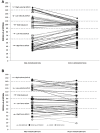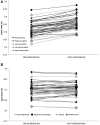Effectiveness of an Individualized Training Based on Force-Velocity Profiling during Jumping
- PMID: 28119624
- PMCID: PMC5220048
- DOI: 10.3389/fphys.2016.00677
Effectiveness of an Individualized Training Based on Force-Velocity Profiling during Jumping
Abstract
Ballistic performances are determined by both the maximal lower limb power output (Pmax ) and their individual force-velocity (F-v) mechanical profile, especially the F-v imbalance (FVimb ): difference between the athlete's actual and optimal profile. An optimized training should aim to increase Pmax and/or reduce FVimb . The aim of this study was to test whether an individualized training program based on the individual F-v profile would decrease subjects' individual FVimb and in turn improve vertical jump performance. FVimb was used as the reference to assign participants to different training intervention groups. Eighty four subjects were assigned to three groups: an "optimized" group divided into velocity-deficit, force-deficit, and well-balanced sub-groups based on subjects' FVimb , a "non-optimized" group for which the training program was not specifically based on FVimb and a control group. All subjects underwent a 9-week specific resistance training program. The programs were designed to reduce FVimb for the optimized groups (with specific programs for sub-groups based on individual FVimb values), while the non-optimized group followed a classical program exactly similar for all subjects. All subjects in the three optimized training sub-groups (velocity-deficit, force-deficit, and well-balanced) increased their jumping performance (12.7 ± 5.7% ES = 0.93 ± 0.09, 14.2 ± 7.3% ES = 1.00 ± 0.17, and 7.2 ± 4.5% ES = 0.70 ± 0.36, respectively) with jump height improvement for all subjects, whereas the results were much more variable and unclear in the non-optimized group. This greater change in jump height was associated with a markedly reduced FVimb for both force-deficit (57.9 ± 34.7% decrease in FVimb ) and velocity-deficit (20.1 ± 4.3%) subjects, and unclear or small changes in Pmax (-0.40 ± 8.4% and +10.5 ± 5.2%, respectively). An individualized training program specifically based on FVimb (gap between the actual and optimal F-v profiles of each individual) was more efficient at improving jumping performance (i.e., unloaded squat jump height) than a traditional resistance training common to all subjects regardless of their FVimb . Although improving both FVimb and Pmax has to be considered to improve ballistic performance, the present results showed that reducing FVimb without even increasing Pmax lead to clearly beneficial jump performance changes. Thus, FVimb could be considered as a potentially useful variable for prescribing optimal resistance training to improve ballistic performance.
Keywords: ballistic training; explosive performance; jumping; maximal power output; resistance strength training.
Figures



References
-
- Baechle T., Earle R. (2000). Essentials of Strength Training and Conditioning, 2nd Edn. Champaign, IL: Human Kinetics.
LinkOut - more resources
Full Text Sources
Other Literature Sources
Miscellaneous

